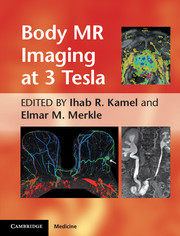Book contents
- Frontmatter
- Contents
- Contributors
- Foreword
- Preface
- Chapter 1 Body MR imaging at 3T: basic considerations about artifacts and safety
- Chapter 2 Novel acquisition techniques that are facilitated by 3T
- Chapter 3 Breast MR imaging
- Chapter 4 Cardiac MR imaging
- Chapter 5 Abdominal and pelvic MR angiography
- Chapter 6 Liver MR imaging at 3T: challenges and opportunities
- Chapter 7 MR imaging of the pancreas
- Chapter 8 MR imaging of the adrenal glands
- Chapter 9 Magnetic resonance cholangiopancreatography
- Chapter 10 MR imaging of small and large bowel
- Chapter 11 MR imaging of the rectum, 3T vs. 1.5T
- Chapter 12 Imaging of the kidneys and MR urography at 3T
- Chapter 13 MR imaging and MR-guided biopsy of the prostate at 3T
- Chapter 14 Female pelvic imaging at 3T
- Index
- Plate section
- References
Chapter 4 - Cardiac MR imaging
Published online by Cambridge University Press: 05 August 2011
- Frontmatter
- Contents
- Contributors
- Foreword
- Preface
- Chapter 1 Body MR imaging at 3T: basic considerations about artifacts and safety
- Chapter 2 Novel acquisition techniques that are facilitated by 3T
- Chapter 3 Breast MR imaging
- Chapter 4 Cardiac MR imaging
- Chapter 5 Abdominal and pelvic MR angiography
- Chapter 6 Liver MR imaging at 3T: challenges and opportunities
- Chapter 7 MR imaging of the pancreas
- Chapter 8 MR imaging of the adrenal glands
- Chapter 9 Magnetic resonance cholangiopancreatography
- Chapter 10 MR imaging of small and large bowel
- Chapter 11 MR imaging of the rectum, 3T vs. 1.5T
- Chapter 12 Imaging of the kidneys and MR urography at 3T
- Chapter 13 MR imaging and MR-guided biopsy of the prostate at 3T
- Chapter 14 Female pelvic imaging at 3T
- Index
- Plate section
- References
Summary
Introduction
Cardiac magnetic resonance (CMR) imaging is routinely used for the diagnosis and management of patients with ischemic and nonischemic heart disease because it can provide a comprehensive, noninvasive evaluation of cardiac morphology, function, perfusion, and viability [1]. In fact, CMR is widely considered the clinical gold standard for assessing right and left ventricular function using balanced steady-state free precession (bSSFP) [2] and determining myocardial viability in patients with ischemic heart disease using inversion recovery (IR) prepared spoiled gradient echo [3]. Technical advances that have improved the spatial and/or temporal resolution of magnetic resonance (MR) imaging have led to improvements in the ability of this modality to visualize pathologic changes in the heart. This has led to an increase in the use of 3T MR imaging scanners for CMR studies.
- Type
- Chapter
- Information
- Body MR Imaging at 3 Tesla , pp. 34 - 46Publisher: Cambridge University PressPrint publication year: 2011

